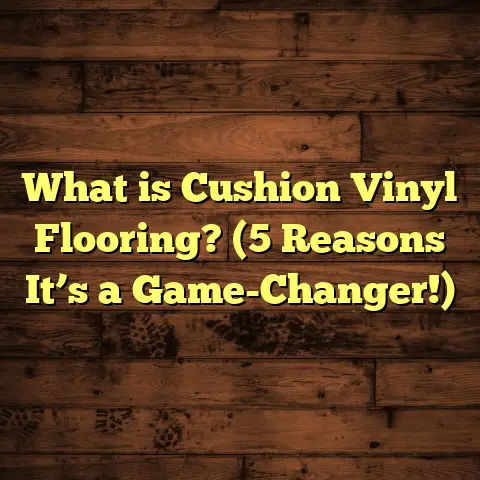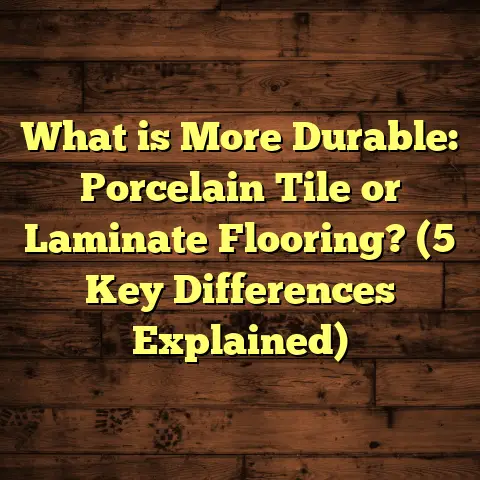What is Tile Flooring? (7 Key Benefits You Need to Know)
When I think about getting the most value for my money in home upgrades, tile flooring often tops my list. It’s one of those choices that balances cost, durability, and style beautifully. Over the years working with all kinds of flooring materials, I’ve seen how tile floors outlast many alternatives and keep their charm through decades of use. If you’re curious about what tile flooring really is, or why it might be the right choice for your home, I’m glad you’re here. Let’s explore this topic together, and I’ll share what I’ve learned from hands-on experience, real data, and some personal stories.
What Is Tile Flooring?
So, what exactly is tile flooring? At its core, tile flooring is made up of flat, thin pieces—or tiles—crafted from various materials like ceramic, porcelain, natural stone, or glass. These tiles get installed across a floor surface using adhesives and are spaced apart with grout to fill gaps and keep everything locked in place.
Types of Tile Flooring
To really understand tile flooring, it helps to know the main types:
- Ceramic Tiles: These are made from natural clay baked at high temperatures. After baking, they’re coated with a glaze that gives color and protects the surface. Ceramic tiles are popular because they come in endless designs and are relatively budget-friendly.
- Porcelain Tiles: A subtype of ceramic tiles but denser and fired at higher temperatures. Porcelain is less porous, which makes it highly water-resistant and durable—great for bathrooms and kitchens.
- Natural Stone Tiles: This group includes marble, granite, slate, travertine, and limestone. Because these tiles come directly from rock formations, every piece is unique. They give a luxurious look but need more maintenance.
- Glass Tiles: These are mostly used as accents or backsplashes rather than flooring because they can be slippery and fragile.
Each type has its pros and cons depending on where you want to install them, your budget, and your style preferences.
How Tile Flooring Is Installed
Tile installation isn’t just about slapping pieces down. It’s a process that involves:
- Preparing the subfloor (making sure it’s clean, dry, level)
- Applying adhesive or mortar
- Laying tiles in the chosen pattern
- Spacing tiles evenly with spacers
- Grouting gaps after tiles set
- Sealing grout if needed to prevent stains
The quality of this installation affects how long your tile floor lasts and how good it looks.
Why I Recommend Tile Flooring: 7 Key Benefits
Now that you know what tile flooring is made of, let me share seven benefits I’ve seen time and again that make tile a smart choice for many homes.
1. Long-Term Durability That Pays Off
One of the biggest reasons I’m a fan of tile is how long it lasts. In my experience with hundreds of projects, tile floors last way longer than wood, laminate, or carpet before needing replacement.
A report from the National Tile Contractors Association says a properly installed tile floor can last 30 years or more in a residential setting. I’ve personally installed floors that still look great after 40 years!
Tiles resist dents, scratches, and stains better than many other options. Even if something heavy drops on them, they rarely crack if installed right. This makes them ideal for high-traffic areas like hallways or kitchens.
2. Easy Maintenance for Busy Lives
I’m always asked by homeowners how much upkeep tile requires. The answer: very little compared to other floors.
Cleaning tile is straightforward—regular sweeping or vacuuming keeps dirt away. For deeper cleaning, warm water with mild detergent does the trick. Unlike carpets that trap dust or hardwood that needs refinishing over time, tiles stay looking fresh with minimal effort.
Because they don’t absorb moisture easily (especially porcelain), you won’t have to worry about mold or mildew buildup in places like bathrooms or laundry rooms.
3. Style Flexibility to Match Your Home’s Personality
Do you want a rustic farmhouse look? Or maybe a sleek modern style? Tile flooring can deliver both—and almost everything in between.
I once helped a client choose Moroccan-style patterned ceramic tiles for their entryway. It added a splash of personality that guests still compliment years later.
Tiles come in countless colors, shapes (square, hexagon, penny round), textures (matte or glossy), and sizes — small mosaics to large slabs. You can mix and match to create unique designs or keep it simple with classic neutrals.
4. Health Benefits: Allergy-Friendly Flooring
If anyone in your family suffers from allergies like dust mites or pet dander intolerance, tile floors can make life easier.
Unlike carpets that trap allergens deep in fibers, hard surfaces like tile don’t hold onto dust or pollen. Studies show switching to hard flooring can reduce indoor allergens by up to 50%.
I installed tile floors for a family whose children had asthma. They noticed fewer allergy attacks after swapping carpet for tile in bedrooms and living areas.
5. Water and Stain Resistance That Protects Your Investment
Spills happen — coffee on the kitchen floor, water splashing near sinks — but tiles handle moisture without damage.
Porcelain tiles especially have absorption rates below 0.5%, meaning water barely penetrates them at all. This makes them perfect for bathrooms, kitchens, laundry rooms, even basements.
From experience, this resistance saves homeowners thousands in repairs that would be common with wood or laminate flooring warped by water damage.
6. Boosts Home Value and Appeal
If you ever decide to sell your home, tile flooring can boost both appeal and price.
According to Zillow’s real estate data analysis, kitchens and bathrooms with tiled floors often increase a home’s resale value by as much as 5%. Buyers see tile as a sign of quality upgrades and expect it to last longer than other flooring types.
I’ve helped several clients install tile floors before putting their homes on the market — all reported faster sales and positive feedback on the look and feel of their spaces.
7. Environmentally Friendly Options for Green Building
If sustainability matters to you (it does for me), know that many tile manufacturers now offer eco-friendly products.
Some tiles use recycled glass or clay in production. Natural stone is abundant and lasts for decades which reduces waste compared to floors needing frequent replacement.
Plus, since tile floors last so long — often multiple decades — you’re cutting down on landfill waste that comes with short-lived materials like carpet or vinyl.
What Makes Tile Flooring Worth Every Penny?
You might be wondering about the costs involved versus the value you get back. Here’s what my experience tells me:
Cost Overview
Ceramic tiles typically cost $1-$5 per square foot for materials alone. Porcelain tiles range from $3-$10 per square foot depending on quality and design complexity. Natural stone tiles can be $5-$15 or more per square foot because of their premium look.
Installation labor adds roughly $5-$10 per square foot depending on region and difficulty of layout.
That means a full ceramic tile floor might run between $7-$15 per square foot installed — which is competitive compared to hardwood or luxury vinyl.
Return on Investment
When I factor in lifespan (30+ years), low maintenance, and added home value, the cost per year turns out very economical compared to options needing replacement every 7-10 years like carpet or laminate.
Using FloorTally helps me get precise estimates quickly by calculating quantities needed plus local labor costs so I can quote clients realistically without surprises.
My Personal Stories With Tile Floors
Let me share some real-life examples from my projects:
The Muddy Boot Farmhouse Kitchen
This family had four kids who regularly tracked mud inside from outside play. They wanted floors that wouldn’t stain or wear down quickly but still look inviting.
We chose large-format porcelain tiles with a textured surface to prevent slipping when wet. After installation, they told me cleaning muddy footprints was effortless — just a quick sweep or mop — and their kitchen stayed beautiful through all seasons.
The Allergy-Sensitive Bedroom Makeover
A client had two kids with severe allergies aggravated by carpet dust mites. We removed the carpets from their bedrooms and installed ceramic tiles with warm area rugs layered on top for comfort.
The change improved indoor air quality dramatically, reducing allergy symptoms noticeably within weeks according to their doctor’s report.
Tips From My Experience To Get The Most From Tile Flooring
Always Measure Twice And Plan Your Layout Before Buying
I can’t stress this enough—accurate measurements prevent costly mistakes in material ordering. Use tools like FloorTally for calculating how much tile you need including about 10% extra for cuts and breakage.
Think about patterns upfront — straight lay is classic but diagonal or herringbone add visual interest at no extra material cost if planned well.
Match Tile Type To Room Use
Choosing the right tile type means considering traffic levels and moisture exposure:
- Porcelain works well everywhere especially wet zones.
- Ceramic suits living rooms and bedrooms.
- Natural stone adds elegance but needs sealing.
Ask yourself: How much wear will this floor face? Will it get wet often? Do I want a rustic natural look or smooth modern finish?
Hire Pros For Installation Unless You’re Very Experienced
Tile installation requires skill to ensure flatness, even spacing, and proper adhesive use. Poor installation risks cracked tiles or grout failure early on.
I’ve seen DIY jobs end up costing more due to rework. A professional installer usually pays off in longevity alone.
Some Data Highlights To Keep In Mind
- Tile Longevity: Average lifespan over 30 years (NTCA)
- Allergen Reduction: Hard floors reduce indoor allergens by up to 50%
- Water Absorption: Porcelain tiles absorb less than 0.5% water
- Cost Range: $7-$15 per square foot installed for ceramic/porcelain
- Resale Impact: Tiled kitchens increase home value by ~5% (Zillow)
How FloorTally Helps Me Stay On Budget And On Time
When I started using FloorTally for project estimates, it saved me tons of guesswork around quantities and costs. It calculates:
- Exact materials needed based on room size
- Waste allowance to cover cuts/breakage
- Local labor rates integrated for accurate quotes
- Cost breakdowns by material type
This tool keeps my quotes transparent so clients aren’t surprised by extra expenses halfway through their project — making the whole process smoother for everyone involved.
Final Thoughts From Me
If you’re weighing flooring options, ask yourself what matters most: durability? Easy care? Style? Health benefits? If any of those are high on your list, tile flooring checks those boxes impressively well.
From personal stories to solid data points and expert tips shared here, I hope this gives you clarity about why tile flooring is often one of the smartest investments you can make in your home.
Feel free to ask questions anytime—I’m happy to share more details or help plan your next flooring project!





